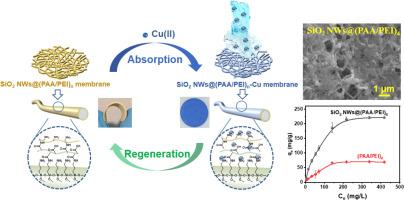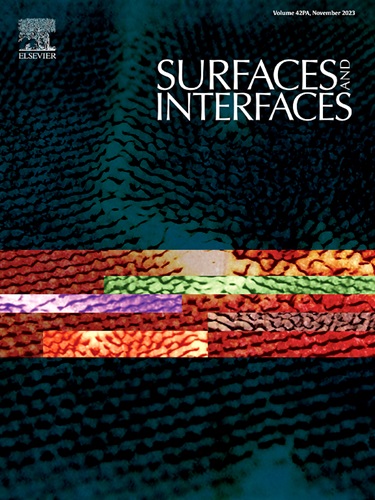用于高效吸附分离水中铜离子的三维组装聚电解质多层功能化二氧化硅纳米线膜
IF 6.3
2区 材料科学
Q2 CHEMISTRY, PHYSICAL
引用次数: 0
摘要
环境处理领域对去除重金属离子的高性能材料有很高的要求。膜吸附具有操作简便、避免二次污染等优点。但要制备出既具有高去除率又具有高渗透性的吸附膜,仍然具有挑战性。在此,我们提出了一种在高孔隙网络上制备具有丰富的多种官能团的聚丙烯酸(PAA)和聚乙烯亚胺(PEI)多层组装二氧化硅纳米线(SiO2 NWs)膜的新策略,用于捕集 Cu(II)。混合膜中的二氧化硅纳米线是一种刚性三维框架,可提高膜的孔隙率和水通量,而组装在二氧化硅纳米线上的聚电解质多层膜则为铜(II)的吸收提供了丰富的、高度可及的吸附位点。膜的吸附容量可通过改变组装的二氧化硅氮核和 PAA/PEI 对层的用量来调节。SiO2 NWs@(PAA/PEI)4复合膜活性聚电解质层对Cu(II)的最大吸附容量为272.5 mg/g,优于去掉SiO2 NWs框架后的(PAA/PEI)4膜(97.5 mg/g)。在动态吸附模式下,该混合膜在去除低浓度的 Cu(II) 方面表现出卓越的吸附性能,而且在八次循环后去除率仍保持在 90% 以上。本文章由计算机程序翻译,如有差异,请以英文原文为准。

Three-dimensionally assembled polyelectrolyte multilayers-functionalized silica nanowire membrane for highly-efficient adsorptive separation of copper ions from water
High-performance materials for heavy metal ion removal are highly demanded in environmental treatment. Membrane adsorption has the advantages of being easy to operate and avoiding secondary pollution. It remains challenging to prepare adsorption membranes with both high removal rate and high permeability. Here, we present a novel strategy for preparing poly(acrylic acid) (PAA) and polyethyleneimine (PEI) multilayer-assembled silica nanowires (SiO2 NWs) membrane with abundant, multiple functional groups on a highly porous network for Cu(II) capture. The SiO2 NWs in the hybrid membranes serve as a rigid 3D framework to improve membrane porosity and water flux, while the polyelectrolyte multilayers assembled on the SiO2 NWs provide abundant, highly accessible adsorption sites for Cu(II) uptake. The adsorption capacity of the membranes can be tuned by changing the dosage of the assembled SiO2 NWs and the PAA/PEI pair layers. The maximum adsorption capacity of the active polyelectrolyte layer for SiO2 NWs@(PAA/PEI)4 composite membrane was 272.5 mg/g toward Cu(II), outperforming the counterpart (PAA/PEI)4 membrane (97.5 mg/g) after removal of the SiO2 NWs framework. The hybrid membrane shows excellent adsorption performance for the removal of low concentrations of Cu(II) in a dynamic adsorption mode, and the removal rate is maintained at above 90 % after eight recycles.
求助全文
通过发布文献求助,成功后即可免费获取论文全文。
去求助
来源期刊

Surfaces and Interfaces
Chemistry-General Chemistry
CiteScore
8.50
自引率
6.50%
发文量
753
审稿时长
35 days
期刊介绍:
The aim of the journal is to provide a respectful outlet for ''sound science'' papers in all research areas on surfaces and interfaces. We define sound science papers as papers that describe new and well-executed research, but that do not necessarily provide brand new insights or are merely a description of research results.
Surfaces and Interfaces publishes research papers in all fields of surface science which may not always find the right home on first submission to our Elsevier sister journals (Applied Surface, Surface and Coatings Technology, Thin Solid Films)
 求助内容:
求助内容: 应助结果提醒方式:
应助结果提醒方式:


